Budget & Commercial Management Discussion Paper: Project Finance
VerifiedAdded on 2022/08/25
|16
|4579
|12
Report
AI Summary
This discussion paper provides a comprehensive overview of budget and commercial management, delving into key areas such as business case analysis, requirements for project funding, the benefits and pitfalls of Special Purpose Vehicles (SPVs), and buyer-supplier management. It further explores the sustainability of business projects, critically analyzes tendering and contracting frameworks, assesses the value and challenges of negotiations, and outlines the procurement management process. The paper also covers the specifications of the decision-making process and concludes with an analysis of Earned Value Management (EVM) including a case study. The report also includes an in-depth analysis of the M6 Toll Road and the Boreas offshore wind portfolio and their associated financial and operational strategies.
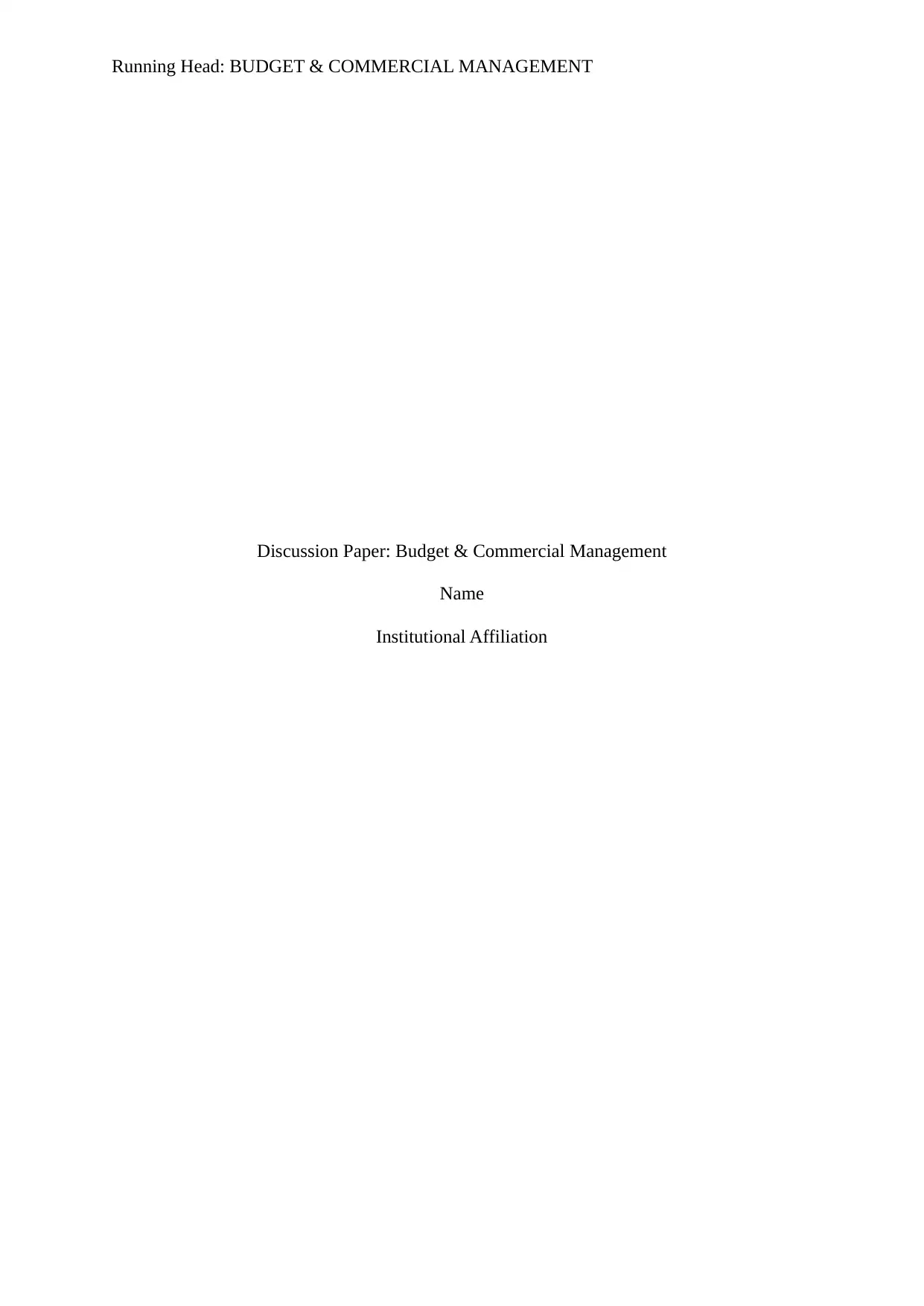
Running Head: BUDGET & COMMERCIAL MANAGEMENT
Discussion Paper: Budget & Commercial Management
Name
Institutional Affiliation
Discussion Paper: Budget & Commercial Management
Name
Institutional Affiliation
Paraphrase This Document
Need a fresh take? Get an instant paraphrase of this document with our AI Paraphraser
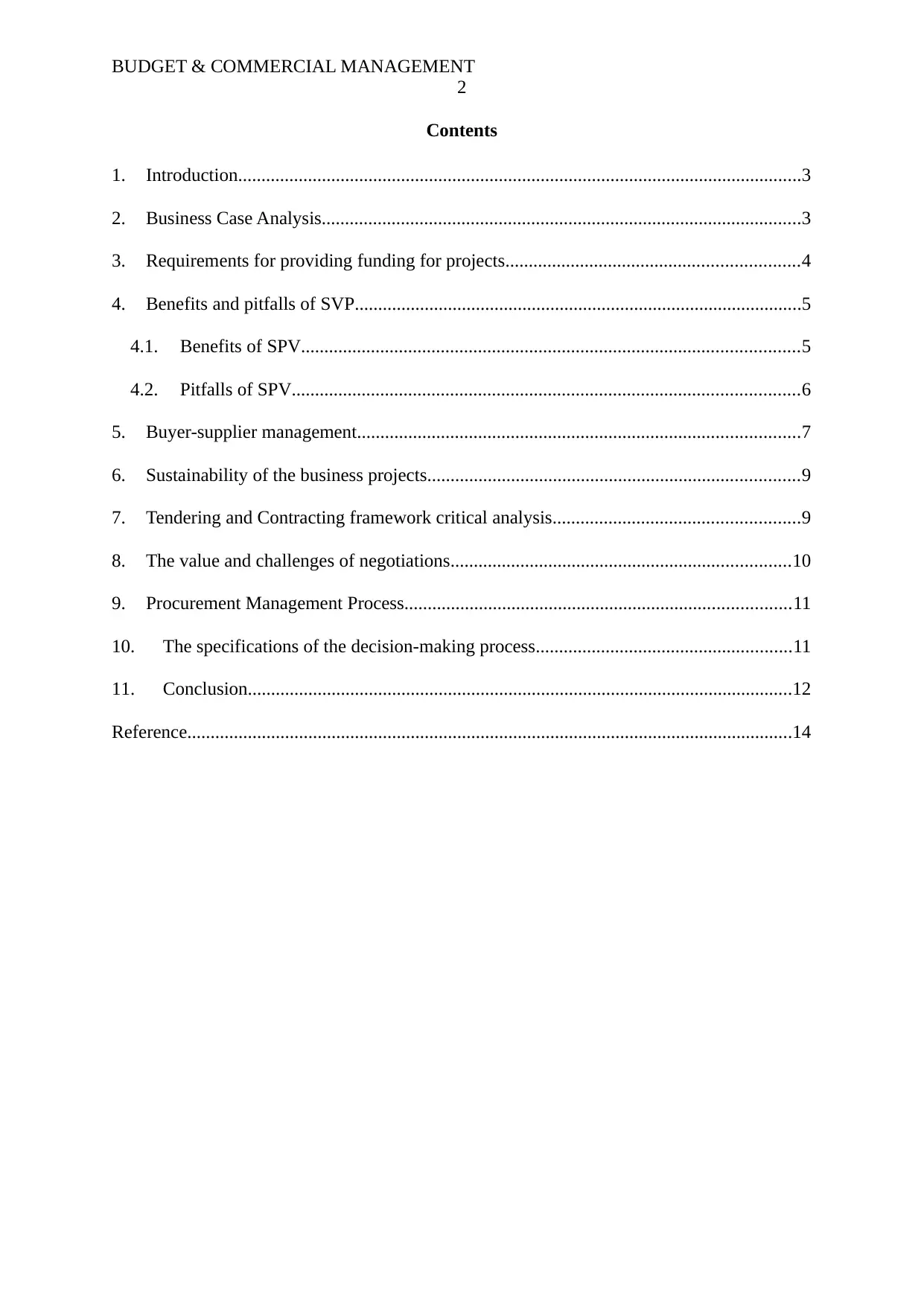
BUDGET & COMMERCIAL MANAGEMENT
2
Contents
1. Introduction.........................................................................................................................3
2. Business Case Analysis.......................................................................................................3
3. Requirements for providing funding for projects...............................................................4
4. Benefits and pitfalls of SVP................................................................................................5
4.1. Benefits of SPV...........................................................................................................5
4.2. Pitfalls of SPV.............................................................................................................6
5. Buyer-supplier management...............................................................................................7
6. Sustainability of the business projects................................................................................9
7. Tendering and Contracting framework critical analysis.....................................................9
8. The value and challenges of negotiations.........................................................................10
9. Procurement Management Process...................................................................................11
10. The specifications of the decision-making process.......................................................11
11. Conclusion.....................................................................................................................12
Reference..................................................................................................................................14
2
Contents
1. Introduction.........................................................................................................................3
2. Business Case Analysis.......................................................................................................3
3. Requirements for providing funding for projects...............................................................4
4. Benefits and pitfalls of SVP................................................................................................5
4.1. Benefits of SPV...........................................................................................................5
4.2. Pitfalls of SPV.............................................................................................................6
5. Buyer-supplier management...............................................................................................7
6. Sustainability of the business projects................................................................................9
7. Tendering and Contracting framework critical analysis.....................................................9
8. The value and challenges of negotiations.........................................................................10
9. Procurement Management Process...................................................................................11
10. The specifications of the decision-making process.......................................................11
11. Conclusion.....................................................................................................................12
Reference..................................................................................................................................14
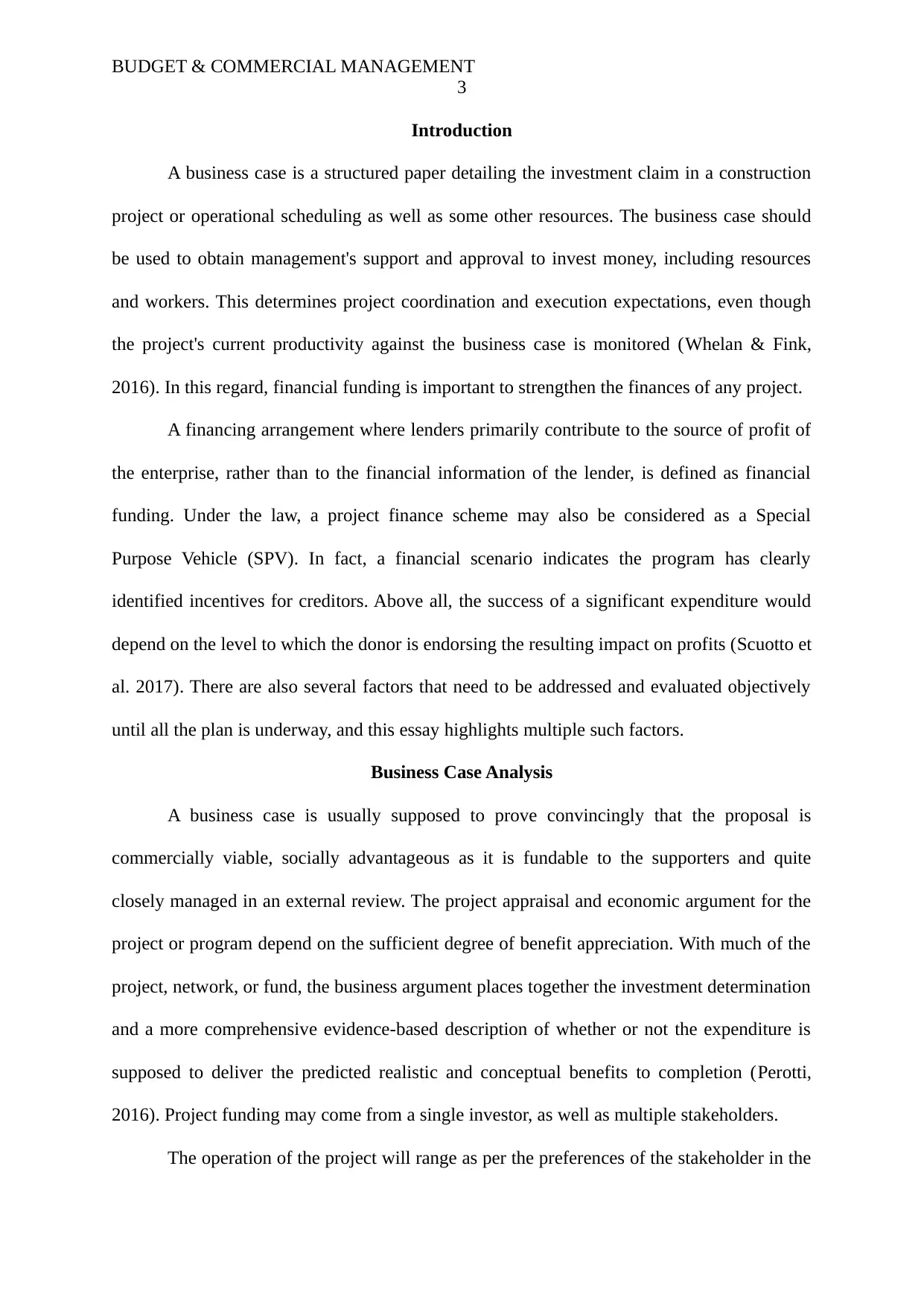
BUDGET & COMMERCIAL MANAGEMENT
3
Introduction
A business case is a structured paper detailing the investment claim in a construction
project or operational scheduling as well as some other resources. The business case should
be used to obtain management's support and approval to invest money, including resources
and workers. This determines project coordination and execution expectations, even though
the project's current productivity against the business case is monitored (Whelan & Fink,
2016). In this regard, financial funding is important to strengthen the finances of any project.
A financing arrangement where lenders primarily contribute to the source of profit of
the enterprise, rather than to the financial information of the lender, is defined as financial
funding. Under the law, a project finance scheme may also be considered as a Special
Purpose Vehicle (SPV). In fact, a financial scenario indicates the program has clearly
identified incentives for creditors. Above all, the success of a significant expenditure would
depend on the level to which the donor is endorsing the resulting impact on profits (Scuotto et
al. 2017). There are also several factors that need to be addressed and evaluated objectively
until all the plan is underway, and this essay highlights multiple such factors.
Business Case Analysis
A business case is usually supposed to prove convincingly that the proposal is
commercially viable, socially advantageous as it is fundable to the supporters and quite
closely managed in an external review. The project appraisal and economic argument for the
project or program depend on the sufficient degree of benefit appreciation. With much of the
project, network, or fund, the business argument places together the investment determination
and a more comprehensive evidence-based description of whether or not the expenditure is
supposed to deliver the predicted realistic and conceptual benefits to completion (Perotti,
2016). Project funding may come from a single investor, as well as multiple stakeholders.
The operation of the project will range as per the preferences of the stakeholder in the
3
Introduction
A business case is a structured paper detailing the investment claim in a construction
project or operational scheduling as well as some other resources. The business case should
be used to obtain management's support and approval to invest money, including resources
and workers. This determines project coordination and execution expectations, even though
the project's current productivity against the business case is monitored (Whelan & Fink,
2016). In this regard, financial funding is important to strengthen the finances of any project.
A financing arrangement where lenders primarily contribute to the source of profit of
the enterprise, rather than to the financial information of the lender, is defined as financial
funding. Under the law, a project finance scheme may also be considered as a Special
Purpose Vehicle (SPV). In fact, a financial scenario indicates the program has clearly
identified incentives for creditors. Above all, the success of a significant expenditure would
depend on the level to which the donor is endorsing the resulting impact on profits (Scuotto et
al. 2017). There are also several factors that need to be addressed and evaluated objectively
until all the plan is underway, and this essay highlights multiple such factors.
Business Case Analysis
A business case is usually supposed to prove convincingly that the proposal is
commercially viable, socially advantageous as it is fundable to the supporters and quite
closely managed in an external review. The project appraisal and economic argument for the
project or program depend on the sufficient degree of benefit appreciation. With much of the
project, network, or fund, the business argument places together the investment determination
and a more comprehensive evidence-based description of whether or not the expenditure is
supposed to deliver the predicted realistic and conceptual benefits to completion (Perotti,
2016). Project funding may come from a single investor, as well as multiple stakeholders.
The operation of the project will range as per the preferences of the stakeholder in the
⊘ This is a preview!⊘
Do you want full access?
Subscribe today to unlock all pages.

Trusted by 1+ million students worldwide
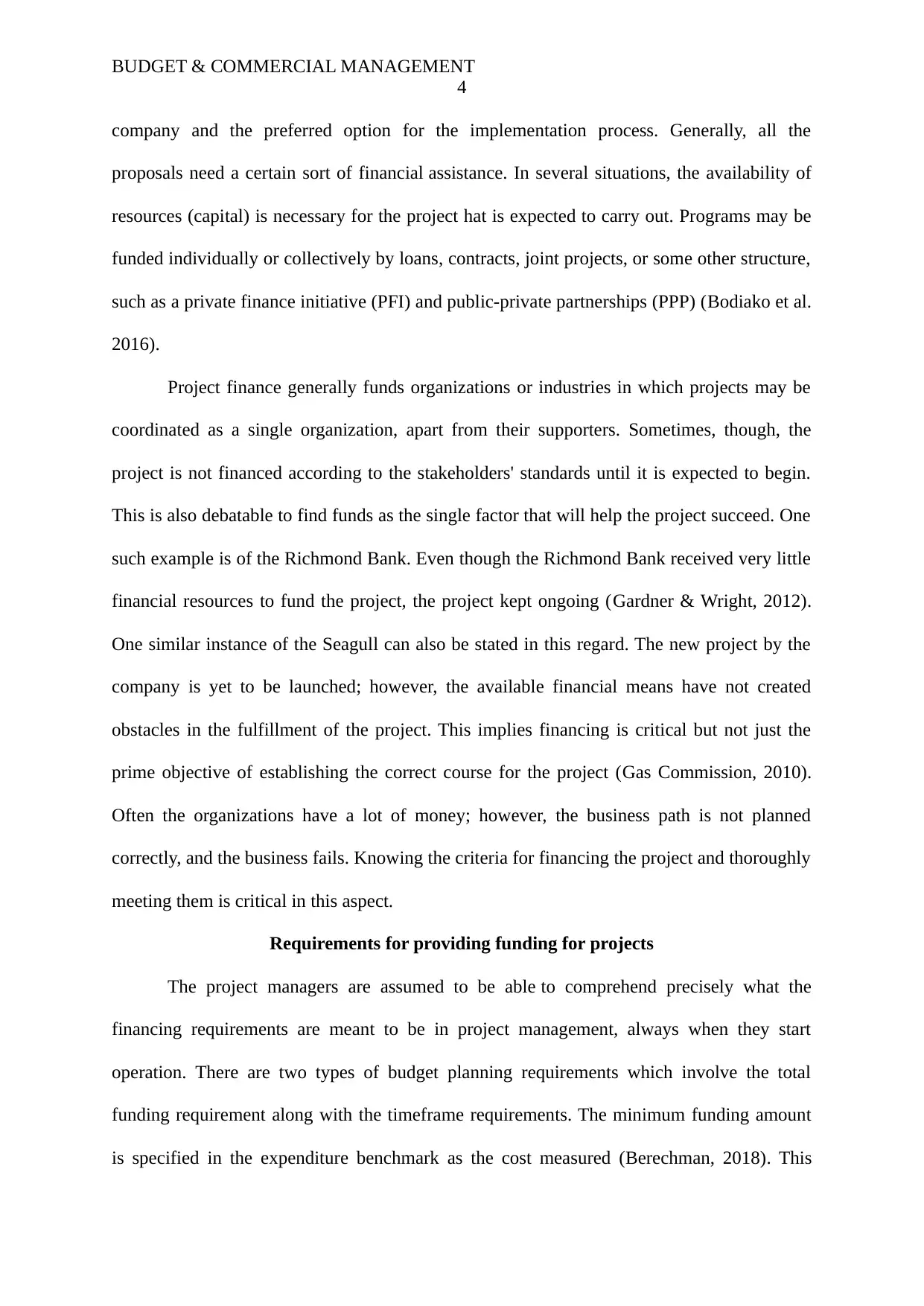
BUDGET & COMMERCIAL MANAGEMENT
4
company and the preferred option for the implementation process. Generally, all the
proposals need a certain sort of financial assistance. In several situations, the availability of
resources (capital) is necessary for the project hat is expected to carry out. Programs may be
funded individually or collectively by loans, contracts, joint projects, or some other structure,
such as a private finance initiative (PFI) and public-private partnerships (PPP) (Bodiako et al.
2016).
Project finance generally funds organizations or industries in which projects may be
coordinated as a single organization, apart from their supporters. Sometimes, though, the
project is not financed according to the stakeholders' standards until it is expected to begin.
This is also debatable to find funds as the single factor that will help the project succeed. One
such example is of the Richmond Bank. Even though the Richmond Bank received very little
financial resources to fund the project, the project kept ongoing (Gardner & Wright, 2012).
One similar instance of the Seagull can also be stated in this regard. The new project by the
company is yet to be launched; however, the available financial means have not created
obstacles in the fulfillment of the project. This implies financing is critical but not just the
prime objective of establishing the correct course for the project (Gas Commission, 2010).
Often the organizations have a lot of money; however, the business path is not planned
correctly, and the business fails. Knowing the criteria for financing the project and thoroughly
meeting them is critical in this aspect.
Requirements for providing funding for projects
The project managers are assumed to be able to comprehend precisely what the
financing requirements are meant to be in project management, always when they start
operation. There are two types of budget planning requirements which involve the total
funding requirement along with the timeframe requirements. The minimum funding amount
is specified in the expenditure benchmark as the cost measured (Berechman, 2018). This
4
company and the preferred option for the implementation process. Generally, all the
proposals need a certain sort of financial assistance. In several situations, the availability of
resources (capital) is necessary for the project hat is expected to carry out. Programs may be
funded individually or collectively by loans, contracts, joint projects, or some other structure,
such as a private finance initiative (PFI) and public-private partnerships (PPP) (Bodiako et al.
2016).
Project finance generally funds organizations or industries in which projects may be
coordinated as a single organization, apart from their supporters. Sometimes, though, the
project is not financed according to the stakeholders' standards until it is expected to begin.
This is also debatable to find funds as the single factor that will help the project succeed. One
such example is of the Richmond Bank. Even though the Richmond Bank received very little
financial resources to fund the project, the project kept ongoing (Gardner & Wright, 2012).
One similar instance of the Seagull can also be stated in this regard. The new project by the
company is yet to be launched; however, the available financial means have not created
obstacles in the fulfillment of the project. This implies financing is critical but not just the
prime objective of establishing the correct course for the project (Gas Commission, 2010).
Often the organizations have a lot of money; however, the business path is not planned
correctly, and the business fails. Knowing the criteria for financing the project and thoroughly
meeting them is critical in this aspect.
Requirements for providing funding for projects
The project managers are assumed to be able to comprehend precisely what the
financing requirements are meant to be in project management, always when they start
operation. There are two types of budget planning requirements which involve the total
funding requirement along with the timeframe requirements. The minimum funding amount
is specified in the expenditure benchmark as the cost measured (Berechman, 2018). This
Paraphrase This Document
Need a fresh take? Get an instant paraphrase of this document with our AI Paraphraser
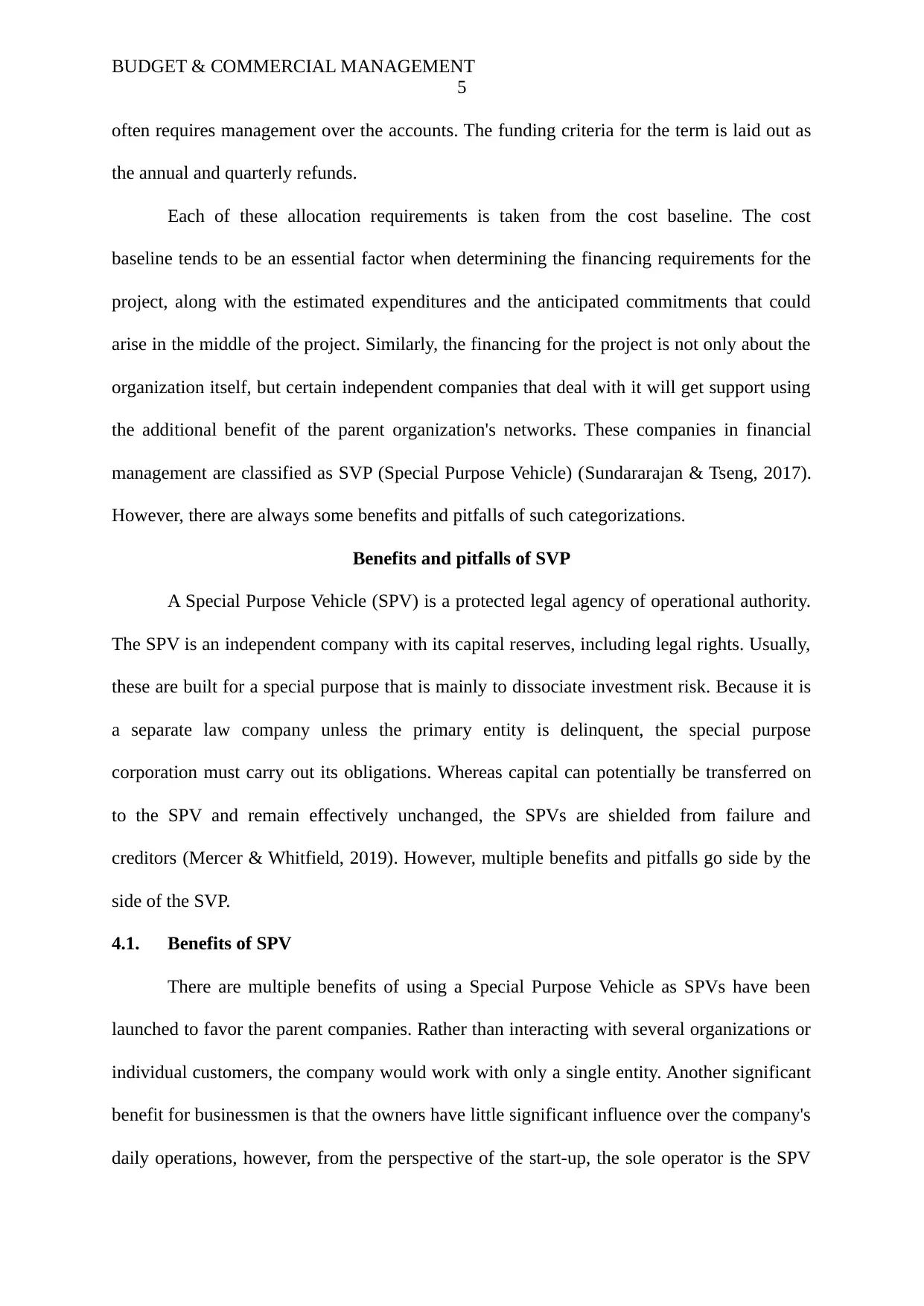
BUDGET & COMMERCIAL MANAGEMENT
5
often requires management over the accounts. The funding criteria for the term is laid out as
the annual and quarterly refunds.
Each of these allocation requirements is taken from the cost baseline. The cost
baseline tends to be an essential factor when determining the financing requirements for the
project, along with the estimated expenditures and the anticipated commitments that could
arise in the middle of the project. Similarly, the financing for the project is not only about the
organization itself, but certain independent companies that deal with it will get support using
the additional benefit of the parent organization's networks. These companies in financial
management are classified as SVP (Special Purpose Vehicle) (Sundararajan & Tseng, 2017).
However, there are always some benefits and pitfalls of such categorizations.
Benefits and pitfalls of SVP
A Special Purpose Vehicle (SPV) is a protected legal agency of operational authority.
The SPV is an independent company with its capital reserves, including legal rights. Usually,
these are built for a special purpose that is mainly to dissociate investment risk. Because it is
a separate law company unless the primary entity is delinquent, the special purpose
corporation must carry out its obligations. Whereas capital can potentially be transferred on
to the SPV and remain effectively unchanged, the SPVs are shielded from failure and
creditors (Mercer & Whitfield, 2019). However, multiple benefits and pitfalls go side by the
side of the SVP.
4.1. Benefits of SPV
There are multiple benefits of using a Special Purpose Vehicle as SPVs have been
launched to favor the parent companies. Rather than interacting with several organizations or
individual customers, the company would work with only a single entity. Another significant
benefit for businessmen is that the owners have little significant influence over the company's
daily operations, however, from the perspective of the start-up, the sole operator is the SPV
5
often requires management over the accounts. The funding criteria for the term is laid out as
the annual and quarterly refunds.
Each of these allocation requirements is taken from the cost baseline. The cost
baseline tends to be an essential factor when determining the financing requirements for the
project, along with the estimated expenditures and the anticipated commitments that could
arise in the middle of the project. Similarly, the financing for the project is not only about the
organization itself, but certain independent companies that deal with it will get support using
the additional benefit of the parent organization's networks. These companies in financial
management are classified as SVP (Special Purpose Vehicle) (Sundararajan & Tseng, 2017).
However, there are always some benefits and pitfalls of such categorizations.
Benefits and pitfalls of SVP
A Special Purpose Vehicle (SPV) is a protected legal agency of operational authority.
The SPV is an independent company with its capital reserves, including legal rights. Usually,
these are built for a special purpose that is mainly to dissociate investment risk. Because it is
a separate law company unless the primary entity is delinquent, the special purpose
corporation must carry out its obligations. Whereas capital can potentially be transferred on
to the SPV and remain effectively unchanged, the SPVs are shielded from failure and
creditors (Mercer & Whitfield, 2019). However, multiple benefits and pitfalls go side by the
side of the SVP.
4.1. Benefits of SPV
There are multiple benefits of using a Special Purpose Vehicle as SPVs have been
launched to favor the parent companies. Rather than interacting with several organizations or
individual customers, the company would work with only a single entity. Another significant
benefit for businessmen is that the owners have little significant influence over the company's
daily operations, however, from the perspective of the start-up, the sole operator is the SPV
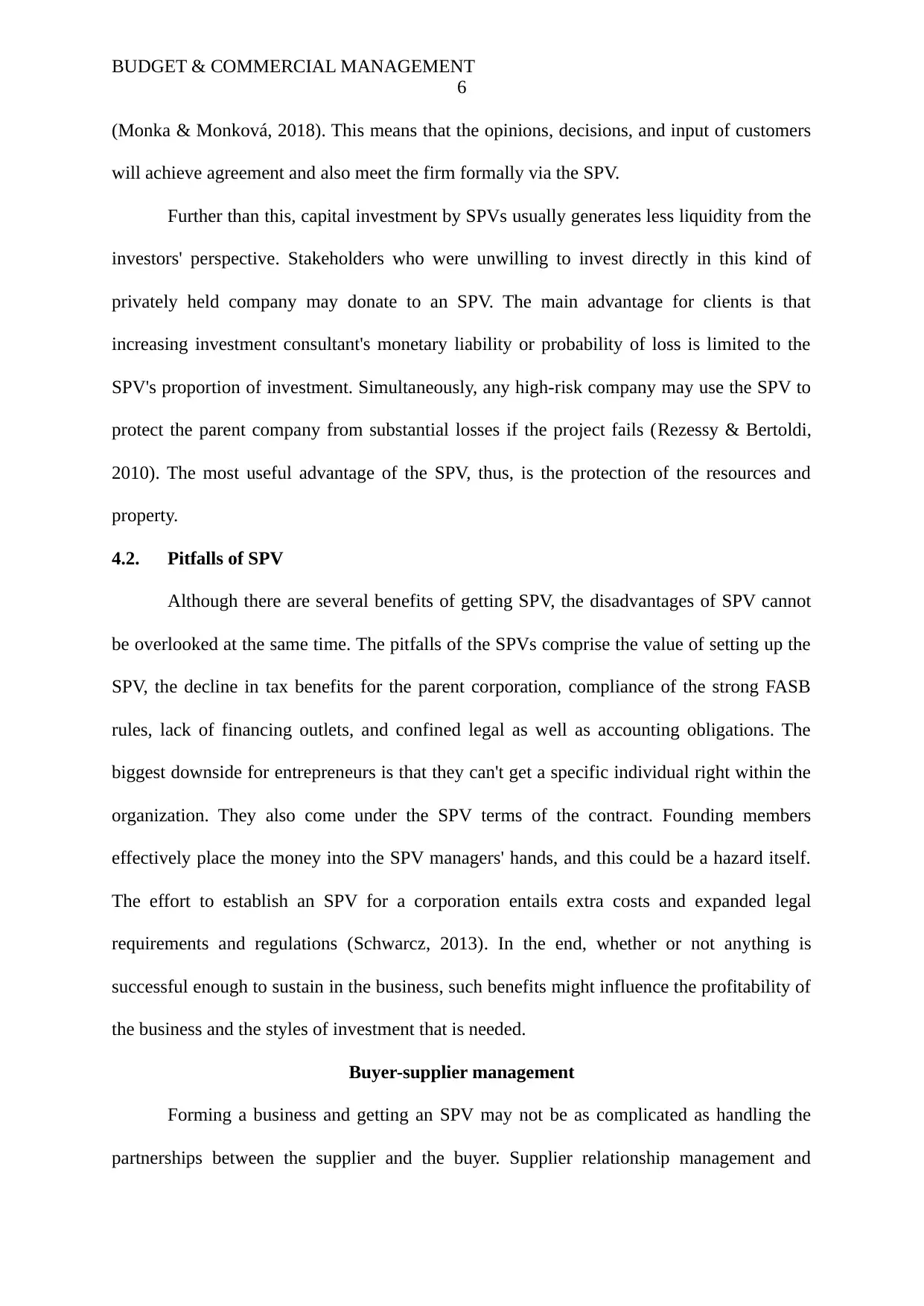
BUDGET & COMMERCIAL MANAGEMENT
6
(Monka & Monková, 2018). This means that the opinions, decisions, and input of customers
will achieve agreement and also meet the firm formally via the SPV.
Further than this, capital investment by SPVs usually generates less liquidity from the
investors' perspective. Stakeholders who were unwilling to invest directly in this kind of
privately held company may donate to an SPV. The main advantage for clients is that
increasing investment consultant's monetary liability or probability of loss is limited to the
SPV's proportion of investment. Simultaneously, any high-risk company may use the SPV to
protect the parent company from substantial losses if the project fails (Rezessy & Bertoldi,
2010). The most useful advantage of the SPV, thus, is the protection of the resources and
property.
4.2. Pitfalls of SPV
Although there are several benefits of getting SPV, the disadvantages of SPV cannot
be overlooked at the same time. The pitfalls of the SPVs comprise the value of setting up the
SPV, the decline in tax benefits for the parent corporation, compliance of the strong FASB
rules, lack of financing outlets, and confined legal as well as accounting obligations. The
biggest downside for entrepreneurs is that they can't get a specific individual right within the
organization. They also come under the SPV terms of the contract. Founding members
effectively place the money into the SPV managers' hands, and this could be a hazard itself.
The effort to establish an SPV for a corporation entails extra costs and expanded legal
requirements and regulations (Schwarcz, 2013). In the end, whether or not anything is
successful enough to sustain in the business, such benefits might influence the profitability of
the business and the styles of investment that is needed.
Buyer-supplier management
Forming a business and getting an SPV may not be as complicated as handling the
partnerships between the supplier and the buyer. Supplier relationship management and
6
(Monka & Monková, 2018). This means that the opinions, decisions, and input of customers
will achieve agreement and also meet the firm formally via the SPV.
Further than this, capital investment by SPVs usually generates less liquidity from the
investors' perspective. Stakeholders who were unwilling to invest directly in this kind of
privately held company may donate to an SPV. The main advantage for clients is that
increasing investment consultant's monetary liability or probability of loss is limited to the
SPV's proportion of investment. Simultaneously, any high-risk company may use the SPV to
protect the parent company from substantial losses if the project fails (Rezessy & Bertoldi,
2010). The most useful advantage of the SPV, thus, is the protection of the resources and
property.
4.2. Pitfalls of SPV
Although there are several benefits of getting SPV, the disadvantages of SPV cannot
be overlooked at the same time. The pitfalls of the SPVs comprise the value of setting up the
SPV, the decline in tax benefits for the parent corporation, compliance of the strong FASB
rules, lack of financing outlets, and confined legal as well as accounting obligations. The
biggest downside for entrepreneurs is that they can't get a specific individual right within the
organization. They also come under the SPV terms of the contract. Founding members
effectively place the money into the SPV managers' hands, and this could be a hazard itself.
The effort to establish an SPV for a corporation entails extra costs and expanded legal
requirements and regulations (Schwarcz, 2013). In the end, whether or not anything is
successful enough to sustain in the business, such benefits might influence the profitability of
the business and the styles of investment that is needed.
Buyer-supplier management
Forming a business and getting an SPV may not be as complicated as handling the
partnerships between the supplier and the buyer. Supplier relationship management and
⊘ This is a preview!⊘
Do you want full access?
Subscribe today to unlock all pages.

Trusted by 1+ million students worldwide
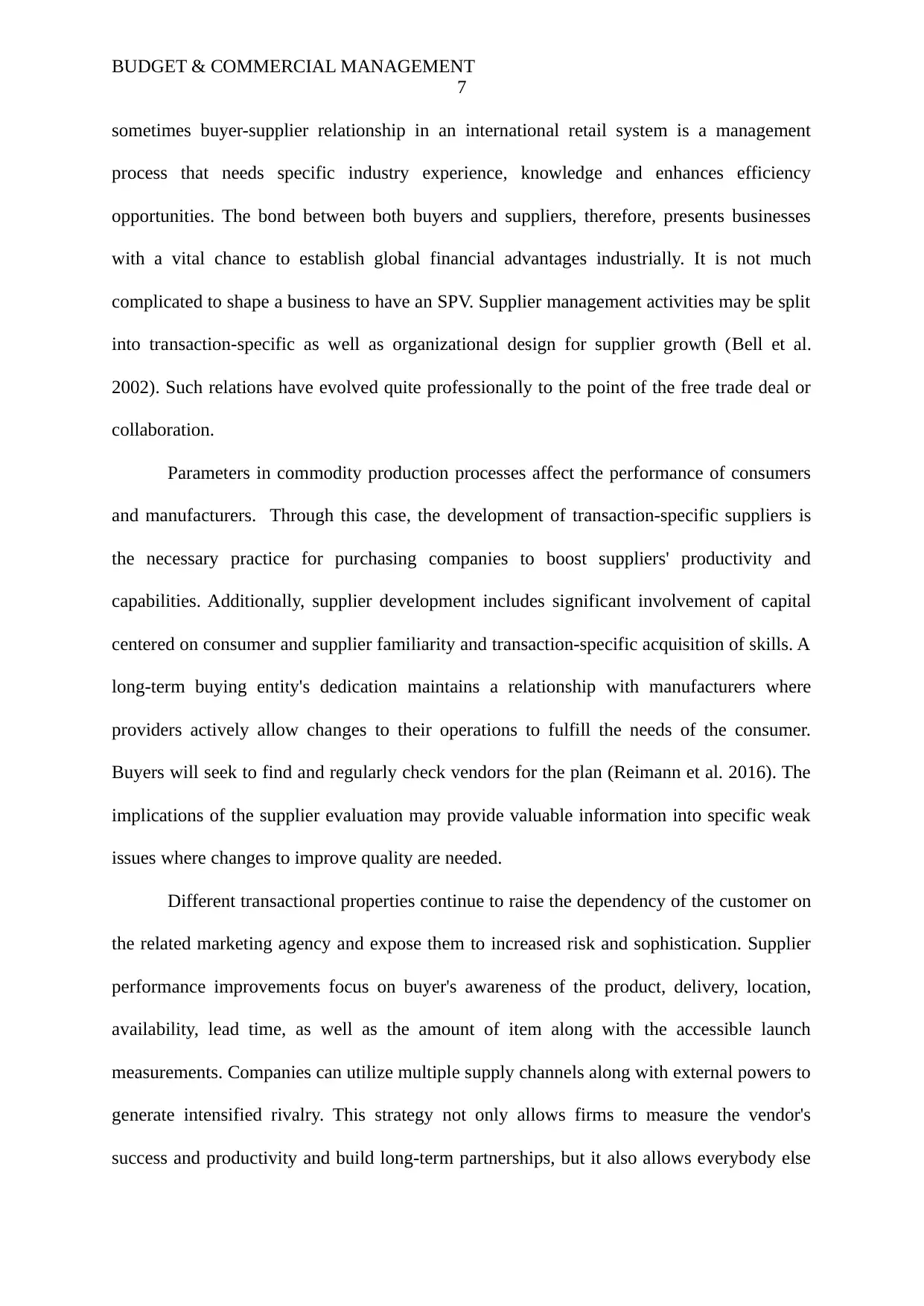
BUDGET & COMMERCIAL MANAGEMENT
7
sometimes buyer-supplier relationship in an international retail system is a management
process that needs specific industry experience, knowledge and enhances efficiency
opportunities. The bond between both buyers and suppliers, therefore, presents businesses
with a vital chance to establish global financial advantages industrially. It is not much
complicated to shape a business to have an SPV. Supplier management activities may be split
into transaction-specific as well as organizational design for supplier growth (Bell et al.
2002). Such relations have evolved quite professionally to the point of the free trade deal or
collaboration.
Parameters in commodity production processes affect the performance of consumers
and manufacturers. Through this case, the development of transaction-specific suppliers is
the necessary practice for purchasing companies to boost suppliers' productivity and
capabilities. Additionally, supplier development includes significant involvement of capital
centered on consumer and supplier familiarity and transaction-specific acquisition of skills. A
long-term buying entity's dedication maintains a relationship with manufacturers where
providers actively allow changes to their operations to fulfill the needs of the consumer.
Buyers will seek to find and regularly check vendors for the plan (Reimann et al. 2016). The
implications of the supplier evaluation may provide valuable information into specific weak
issues where changes to improve quality are needed.
Different transactional properties continue to raise the dependency of the customer on
the related marketing agency and expose them to increased risk and sophistication. Supplier
performance improvements focus on buyer's awareness of the product, delivery, location,
availability, lead time, as well as the amount of item along with the accessible launch
measurements. Companies can utilize multiple supply channels along with external powers to
generate intensified rivalry. This strategy not only allows firms to measure the vendor's
success and productivity and build long-term partnerships, but it also allows everybody else
7
sometimes buyer-supplier relationship in an international retail system is a management
process that needs specific industry experience, knowledge and enhances efficiency
opportunities. The bond between both buyers and suppliers, therefore, presents businesses
with a vital chance to establish global financial advantages industrially. It is not much
complicated to shape a business to have an SPV. Supplier management activities may be split
into transaction-specific as well as organizational design for supplier growth (Bell et al.
2002). Such relations have evolved quite professionally to the point of the free trade deal or
collaboration.
Parameters in commodity production processes affect the performance of consumers
and manufacturers. Through this case, the development of transaction-specific suppliers is
the necessary practice for purchasing companies to boost suppliers' productivity and
capabilities. Additionally, supplier development includes significant involvement of capital
centered on consumer and supplier familiarity and transaction-specific acquisition of skills. A
long-term buying entity's dedication maintains a relationship with manufacturers where
providers actively allow changes to their operations to fulfill the needs of the consumer.
Buyers will seek to find and regularly check vendors for the plan (Reimann et al. 2016). The
implications of the supplier evaluation may provide valuable information into specific weak
issues where changes to improve quality are needed.
Different transactional properties continue to raise the dependency of the customer on
the related marketing agency and expose them to increased risk and sophistication. Supplier
performance improvements focus on buyer's awareness of the product, delivery, location,
availability, lead time, as well as the amount of item along with the accessible launch
measurements. Companies can utilize multiple supply channels along with external powers to
generate intensified rivalry. This strategy not only allows firms to measure the vendor's
success and productivity and build long-term partnerships, but it also allows everybody else
Paraphrase This Document
Need a fresh take? Get an instant paraphrase of this document with our AI Paraphraser
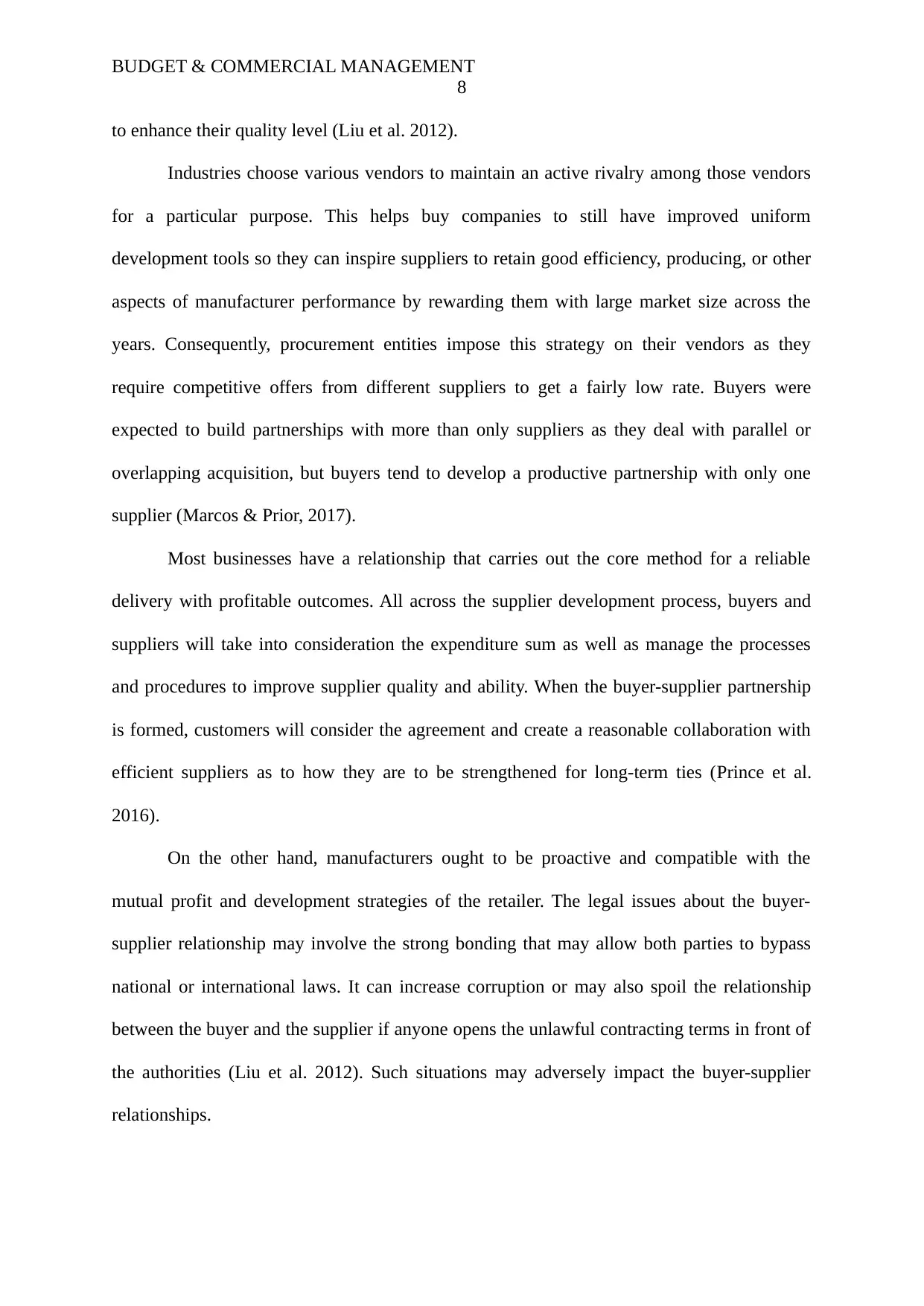
BUDGET & COMMERCIAL MANAGEMENT
8
to enhance their quality level (Liu et al. 2012).
Industries choose various vendors to maintain an active rivalry among those vendors
for a particular purpose. This helps buy companies to still have improved uniform
development tools so they can inspire suppliers to retain good efficiency, producing, or other
aspects of manufacturer performance by rewarding them with large market size across the
years. Consequently, procurement entities impose this strategy on their vendors as they
require competitive offers from different suppliers to get a fairly low rate. Buyers were
expected to build partnerships with more than only suppliers as they deal with parallel or
overlapping acquisition, but buyers tend to develop a productive partnership with only one
supplier (Marcos & Prior, 2017).
Most businesses have a relationship that carries out the core method for a reliable
delivery with profitable outcomes. All across the supplier development process, buyers and
suppliers will take into consideration the expenditure sum as well as manage the processes
and procedures to improve supplier quality and ability. When the buyer-supplier partnership
is formed, customers will consider the agreement and create a reasonable collaboration with
efficient suppliers as to how they are to be strengthened for long-term ties (Prince et al.
2016).
On the other hand, manufacturers ought to be proactive and compatible with the
mutual profit and development strategies of the retailer. The legal issues about the buyer-
supplier relationship may involve the strong bonding that may allow both parties to bypass
national or international laws. It can increase corruption or may also spoil the relationship
between the buyer and the supplier if anyone opens the unlawful contracting terms in front of
the authorities (Liu et al. 2012). Such situations may adversely impact the buyer-supplier
relationships.
8
to enhance their quality level (Liu et al. 2012).
Industries choose various vendors to maintain an active rivalry among those vendors
for a particular purpose. This helps buy companies to still have improved uniform
development tools so they can inspire suppliers to retain good efficiency, producing, or other
aspects of manufacturer performance by rewarding them with large market size across the
years. Consequently, procurement entities impose this strategy on their vendors as they
require competitive offers from different suppliers to get a fairly low rate. Buyers were
expected to build partnerships with more than only suppliers as they deal with parallel or
overlapping acquisition, but buyers tend to develop a productive partnership with only one
supplier (Marcos & Prior, 2017).
Most businesses have a relationship that carries out the core method for a reliable
delivery with profitable outcomes. All across the supplier development process, buyers and
suppliers will take into consideration the expenditure sum as well as manage the processes
and procedures to improve supplier quality and ability. When the buyer-supplier partnership
is formed, customers will consider the agreement and create a reasonable collaboration with
efficient suppliers as to how they are to be strengthened for long-term ties (Prince et al.
2016).
On the other hand, manufacturers ought to be proactive and compatible with the
mutual profit and development strategies of the retailer. The legal issues about the buyer-
supplier relationship may involve the strong bonding that may allow both parties to bypass
national or international laws. It can increase corruption or may also spoil the relationship
between the buyer and the supplier if anyone opens the unlawful contracting terms in front of
the authorities (Liu et al. 2012). Such situations may adversely impact the buyer-supplier
relationships.
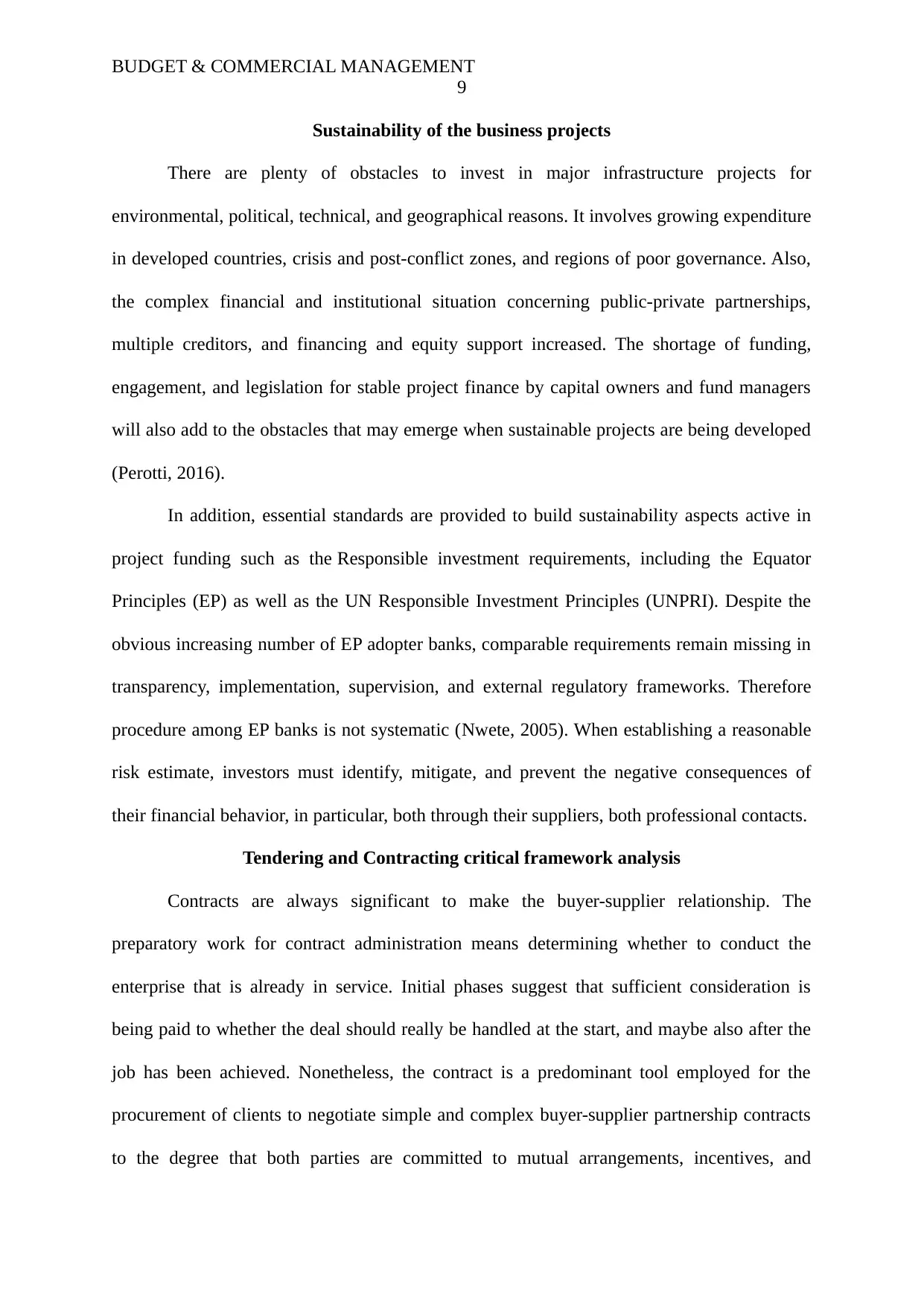
BUDGET & COMMERCIAL MANAGEMENT
9
Sustainability of the business projects
There are plenty of obstacles to invest in major infrastructure projects for
environmental, political, technical, and geographical reasons. It involves growing expenditure
in developed countries, crisis and post-conflict zones, and regions of poor governance. Also,
the complex financial and institutional situation concerning public-private partnerships,
multiple creditors, and financing and equity support increased. The shortage of funding,
engagement, and legislation for stable project finance by capital owners and fund managers
will also add to the obstacles that may emerge when sustainable projects are being developed
(Perotti, 2016).
In addition, essential standards are provided to build sustainability aspects active in
project funding such as the Responsible investment requirements, including the Equator
Principles (EP) as well as the UN Responsible Investment Principles (UNPRI). Despite the
obvious increasing number of EP adopter banks, comparable requirements remain missing in
transparency, implementation, supervision, and external regulatory frameworks. Therefore
procedure among EP banks is not systematic (Nwete, 2005). When establishing a reasonable
risk estimate, investors must identify, mitigate, and prevent the negative consequences of
their financial behavior, in particular, both through their suppliers, both professional contacts.
Tendering and Contracting critical framework analysis
Contracts are always significant to make the buyer-supplier relationship. The
preparatory work for contract administration means determining whether to conduct the
enterprise that is already in service. Initial phases suggest that sufficient consideration is
being paid to whether the deal should really be handled at the start, and maybe also after the
job has been achieved. Nonetheless, the contract is a predominant tool employed for the
procurement of clients to negotiate simple and complex buyer-supplier partnership contracts
to the degree that both parties are committed to mutual arrangements, incentives, and
9
Sustainability of the business projects
There are plenty of obstacles to invest in major infrastructure projects for
environmental, political, technical, and geographical reasons. It involves growing expenditure
in developed countries, crisis and post-conflict zones, and regions of poor governance. Also,
the complex financial and institutional situation concerning public-private partnerships,
multiple creditors, and financing and equity support increased. The shortage of funding,
engagement, and legislation for stable project finance by capital owners and fund managers
will also add to the obstacles that may emerge when sustainable projects are being developed
(Perotti, 2016).
In addition, essential standards are provided to build sustainability aspects active in
project funding such as the Responsible investment requirements, including the Equator
Principles (EP) as well as the UN Responsible Investment Principles (UNPRI). Despite the
obvious increasing number of EP adopter banks, comparable requirements remain missing in
transparency, implementation, supervision, and external regulatory frameworks. Therefore
procedure among EP banks is not systematic (Nwete, 2005). When establishing a reasonable
risk estimate, investors must identify, mitigate, and prevent the negative consequences of
their financial behavior, in particular, both through their suppliers, both professional contacts.
Tendering and Contracting critical framework analysis
Contracts are always significant to make the buyer-supplier relationship. The
preparatory work for contract administration means determining whether to conduct the
enterprise that is already in service. Initial phases suggest that sufficient consideration is
being paid to whether the deal should really be handled at the start, and maybe also after the
job has been achieved. Nonetheless, the contract is a predominant tool employed for the
procurement of clients to negotiate simple and complex buyer-supplier partnership contracts
to the degree that both parties are committed to mutual arrangements, incentives, and
⊘ This is a preview!⊘
Do you want full access?
Subscribe today to unlock all pages.

Trusted by 1+ million students worldwide
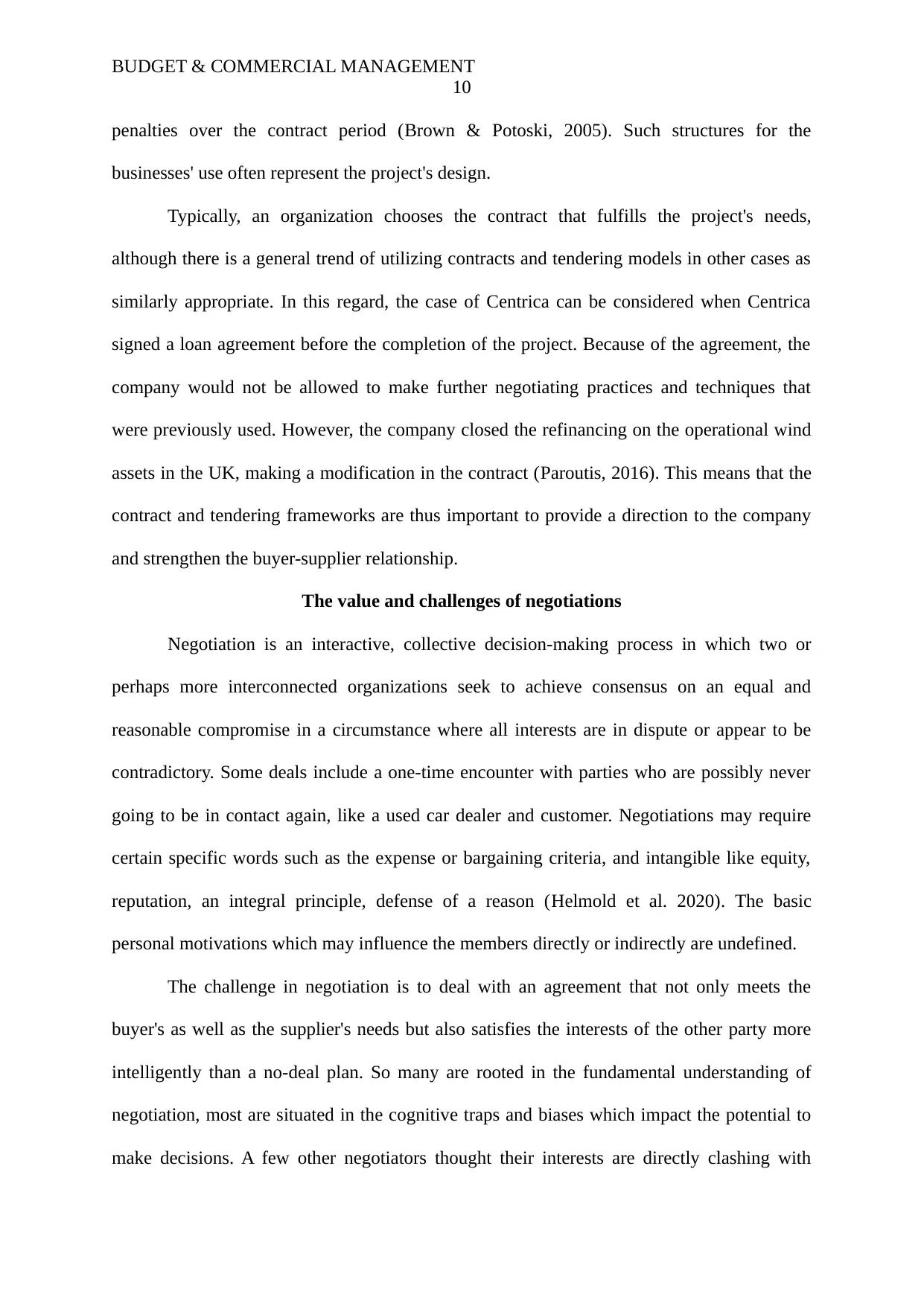
BUDGET & COMMERCIAL MANAGEMENT
10
penalties over the contract period (Brown & Potoski, 2005). Such structures for the
businesses' use often represent the project's design.
Typically, an organization chooses the contract that fulfills the project's needs,
although there is a general trend of utilizing contracts and tendering models in other cases as
similarly appropriate. In this regard, the case of Centrica can be considered when Centrica
signed a loan agreement before the completion of the project. Because of the agreement, the
company would not be allowed to make further negotiating practices and techniques that
were previously used. However, the company closed the refinancing on the operational wind
assets in the UK, making a modification in the contract (Paroutis, 2016). This means that the
contract and tendering frameworks are thus important to provide a direction to the company
and strengthen the buyer-supplier relationship.
The value and challenges of negotiations
Negotiation is an interactive, collective decision-making process in which two or
perhaps more interconnected organizations seek to achieve consensus on an equal and
reasonable compromise in a circumstance where all interests are in dispute or appear to be
contradictory. Some deals include a one-time encounter with parties who are possibly never
going to be in contact again, like a used car dealer and customer. Negotiations may require
certain specific words such as the expense or bargaining criteria, and intangible like equity,
reputation, an integral principle, defense of a reason (Helmold et al. 2020). The basic
personal motivations which may influence the members directly or indirectly are undefined.
The challenge in negotiation is to deal with an agreement that not only meets the
buyer's as well as the supplier's needs but also satisfies the interests of the other party more
intelligently than a no-deal plan. So many are rooted in the fundamental understanding of
negotiation, most are situated in the cognitive traps and biases which impact the potential to
make decisions. A few other negotiators thought their interests are directly clashing with
10
penalties over the contract period (Brown & Potoski, 2005). Such structures for the
businesses' use often represent the project's design.
Typically, an organization chooses the contract that fulfills the project's needs,
although there is a general trend of utilizing contracts and tendering models in other cases as
similarly appropriate. In this regard, the case of Centrica can be considered when Centrica
signed a loan agreement before the completion of the project. Because of the agreement, the
company would not be allowed to make further negotiating practices and techniques that
were previously used. However, the company closed the refinancing on the operational wind
assets in the UK, making a modification in the contract (Paroutis, 2016). This means that the
contract and tendering frameworks are thus important to provide a direction to the company
and strengthen the buyer-supplier relationship.
The value and challenges of negotiations
Negotiation is an interactive, collective decision-making process in which two or
perhaps more interconnected organizations seek to achieve consensus on an equal and
reasonable compromise in a circumstance where all interests are in dispute or appear to be
contradictory. Some deals include a one-time encounter with parties who are possibly never
going to be in contact again, like a used car dealer and customer. Negotiations may require
certain specific words such as the expense or bargaining criteria, and intangible like equity,
reputation, an integral principle, defense of a reason (Helmold et al. 2020). The basic
personal motivations which may influence the members directly or indirectly are undefined.
The challenge in negotiation is to deal with an agreement that not only meets the
buyer's as well as the supplier's needs but also satisfies the interests of the other party more
intelligently than a no-deal plan. So many are rooted in the fundamental understanding of
negotiation, most are situated in the cognitive traps and biases which impact the potential to
make decisions. A few other negotiators thought their interests are directly clashing with
Paraphrase This Document
Need a fresh take? Get an instant paraphrase of this document with our AI Paraphraser
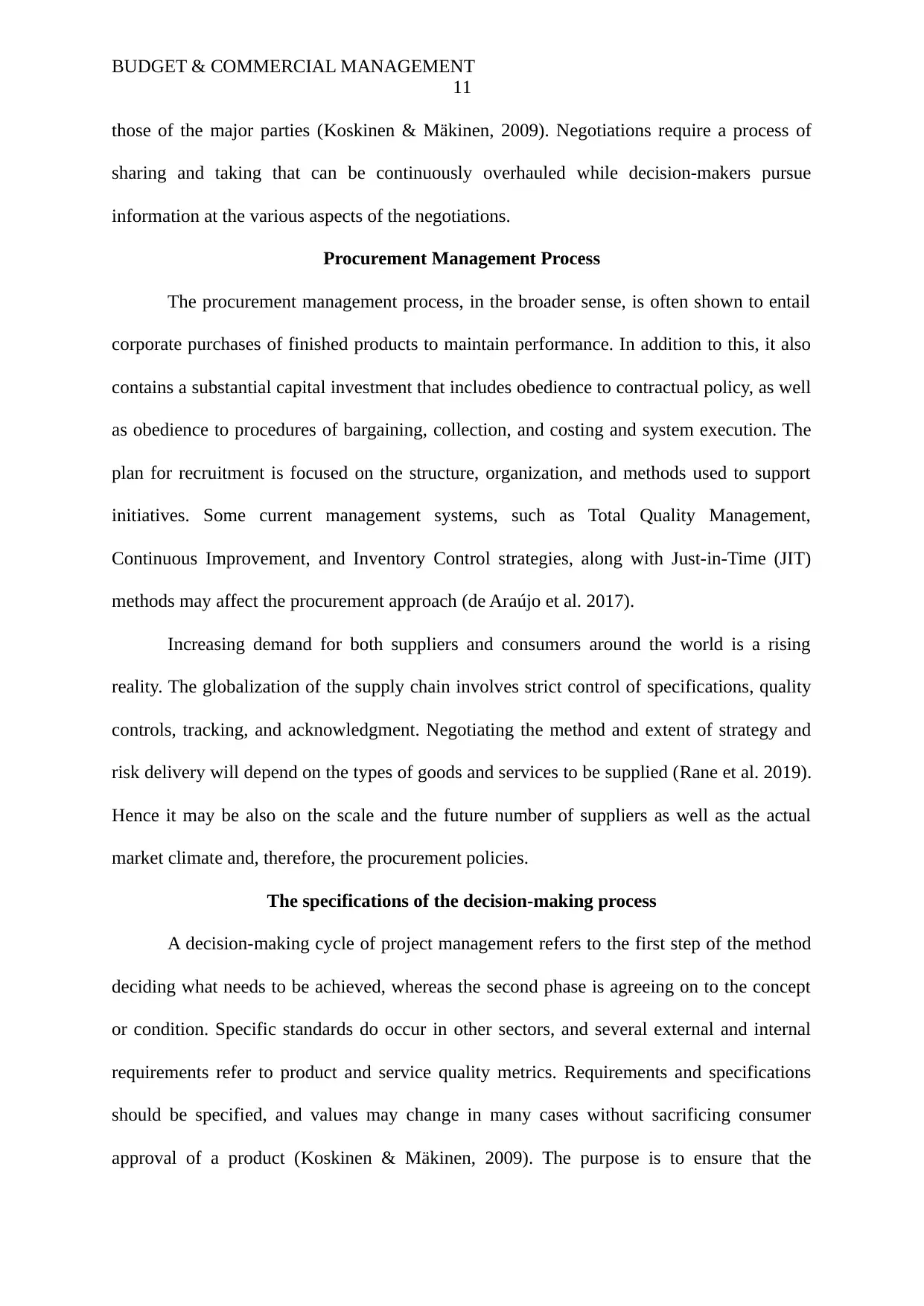
BUDGET & COMMERCIAL MANAGEMENT
11
those of the major parties (Koskinen & Mäkinen, 2009). Negotiations require a process of
sharing and taking that can be continuously overhauled while decision-makers pursue
information at the various aspects of the negotiations.
Procurement Management Process
The procurement management process, in the broader sense, is often shown to entail
corporate purchases of finished products to maintain performance. In addition to this, it also
contains a substantial capital investment that includes obedience to contractual policy, as well
as obedience to procedures of bargaining, collection, and costing and system execution. The
plan for recruitment is focused on the structure, organization, and methods used to support
initiatives. Some current management systems, such as Total Quality Management,
Continuous Improvement, and Inventory Control strategies, along with Just-in-Time (JIT)
methods may affect the procurement approach (de Araújo et al. 2017).
Increasing demand for both suppliers and consumers around the world is a rising
reality. The globalization of the supply chain involves strict control of specifications, quality
controls, tracking, and acknowledgment. Negotiating the method and extent of strategy and
risk delivery will depend on the types of goods and services to be supplied (Rane et al. 2019).
Hence it may be also on the scale and the future number of suppliers as well as the actual
market climate and, therefore, the procurement policies.
The specifications of the decision-making process
A decision-making cycle of project management refers to the first step of the method
deciding what needs to be achieved, whereas the second phase is agreeing on to the concept
or condition. Specific standards do occur in other sectors, and several external and internal
requirements refer to product and service quality metrics. Requirements and specifications
should be specified, and values may change in many cases without sacrificing consumer
approval of a product (Koskinen & Mäkinen, 2009). The purpose is to ensure that the
11
those of the major parties (Koskinen & Mäkinen, 2009). Negotiations require a process of
sharing and taking that can be continuously overhauled while decision-makers pursue
information at the various aspects of the negotiations.
Procurement Management Process
The procurement management process, in the broader sense, is often shown to entail
corporate purchases of finished products to maintain performance. In addition to this, it also
contains a substantial capital investment that includes obedience to contractual policy, as well
as obedience to procedures of bargaining, collection, and costing and system execution. The
plan for recruitment is focused on the structure, organization, and methods used to support
initiatives. Some current management systems, such as Total Quality Management,
Continuous Improvement, and Inventory Control strategies, along with Just-in-Time (JIT)
methods may affect the procurement approach (de Araújo et al. 2017).
Increasing demand for both suppliers and consumers around the world is a rising
reality. The globalization of the supply chain involves strict control of specifications, quality
controls, tracking, and acknowledgment. Negotiating the method and extent of strategy and
risk delivery will depend on the types of goods and services to be supplied (Rane et al. 2019).
Hence it may be also on the scale and the future number of suppliers as well as the actual
market climate and, therefore, the procurement policies.
The specifications of the decision-making process
A decision-making cycle of project management refers to the first step of the method
deciding what needs to be achieved, whereas the second phase is agreeing on to the concept
or condition. Specific standards do occur in other sectors, and several external and internal
requirements refer to product and service quality metrics. Requirements and specifications
should be specified, and values may change in many cases without sacrificing consumer
approval of a product (Koskinen & Mäkinen, 2009). The purpose is to ensure that the
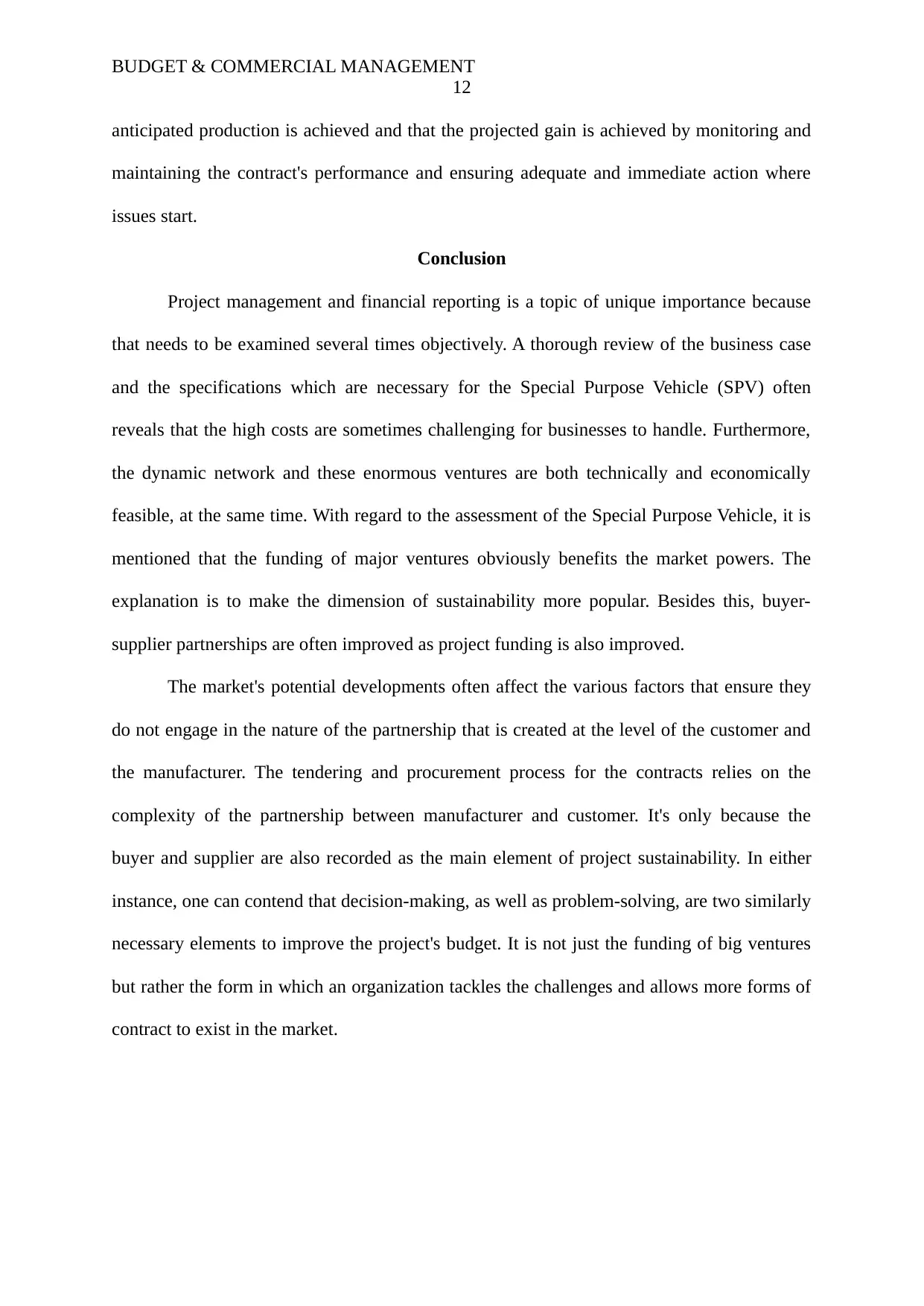
BUDGET & COMMERCIAL MANAGEMENT
12
anticipated production is achieved and that the projected gain is achieved by monitoring and
maintaining the contract's performance and ensuring adequate and immediate action where
issues start.
Conclusion
Project management and financial reporting is a topic of unique importance because
that needs to be examined several times objectively. A thorough review of the business case
and the specifications which are necessary for the Special Purpose Vehicle (SPV) often
reveals that the high costs are sometimes challenging for businesses to handle. Furthermore,
the dynamic network and these enormous ventures are both technically and economically
feasible, at the same time. With regard to the assessment of the Special Purpose Vehicle, it is
mentioned that the funding of major ventures obviously benefits the market powers. The
explanation is to make the dimension of sustainability more popular. Besides this, buyer-
supplier partnerships are often improved as project funding is also improved.
The market's potential developments often affect the various factors that ensure they
do not engage in the nature of the partnership that is created at the level of the customer and
the manufacturer. The tendering and procurement process for the contracts relies on the
complexity of the partnership between manufacturer and customer. It's only because the
buyer and supplier are also recorded as the main element of project sustainability. In either
instance, one can contend that decision-making, as well as problem-solving, are two similarly
necessary elements to improve the project's budget. It is not just the funding of big ventures
but rather the form in which an organization tackles the challenges and allows more forms of
contract to exist in the market.
12
anticipated production is achieved and that the projected gain is achieved by monitoring and
maintaining the contract's performance and ensuring adequate and immediate action where
issues start.
Conclusion
Project management and financial reporting is a topic of unique importance because
that needs to be examined several times objectively. A thorough review of the business case
and the specifications which are necessary for the Special Purpose Vehicle (SPV) often
reveals that the high costs are sometimes challenging for businesses to handle. Furthermore,
the dynamic network and these enormous ventures are both technically and economically
feasible, at the same time. With regard to the assessment of the Special Purpose Vehicle, it is
mentioned that the funding of major ventures obviously benefits the market powers. The
explanation is to make the dimension of sustainability more popular. Besides this, buyer-
supplier partnerships are often improved as project funding is also improved.
The market's potential developments often affect the various factors that ensure they
do not engage in the nature of the partnership that is created at the level of the customer and
the manufacturer. The tendering and procurement process for the contracts relies on the
complexity of the partnership between manufacturer and customer. It's only because the
buyer and supplier are also recorded as the main element of project sustainability. In either
instance, one can contend that decision-making, as well as problem-solving, are two similarly
necessary elements to improve the project's budget. It is not just the funding of big ventures
but rather the form in which an organization tackles the challenges and allows more forms of
contract to exist in the market.
⊘ This is a preview!⊘
Do you want full access?
Subscribe today to unlock all pages.

Trusted by 1+ million students worldwide
1 out of 16
Related Documents
Your All-in-One AI-Powered Toolkit for Academic Success.
+13062052269
info@desklib.com
Available 24*7 on WhatsApp / Email
![[object Object]](/_next/static/media/star-bottom.7253800d.svg)
Unlock your academic potential
Copyright © 2020–2025 A2Z Services. All Rights Reserved. Developed and managed by ZUCOL.




